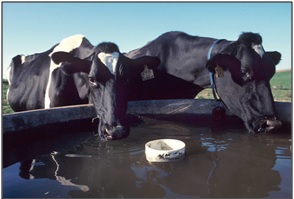Alternate Livestock Water Supply

Description
Providing an alternate livestock drinking water supply away from surface waters can reduce stream bank erosion, prevent the deposition of animal waste within water bodies, protect riparian vegetation, and provide a dependable, clean source of water for livestock. In some locations, artificial shade may also be constructed to encourage use of upland sites for shading and loafing.
Alternative livestock water can be provided through the following practices:
- Pond: A water impoundment made by constructing a dam or an embankment or by excavation of a pit or dugout.
- Trough or Tank: By the installation of troughs or tanks, livestock may be better distributed over the pasture, grazing can be better controlled, and surface runoff reduced, thus reducing erosion.
- Well: A drinking water supply well can be constructed or improved to provide water for livestock.
- Spring Development: This practice includes improving springs and seeps by excavating, cleaning, capping, or providing collection and storage facilities. Temporary erosion and sedimentation may occur from any disturbed areas during and immediately following any related construction activities.
- Pipeline/Pump System: A gravity pipeline or pump system can be developed in combination with the practices described above to increase to distance between a water source (e.g., well, spring) and targeted water supply areas within the pasture.